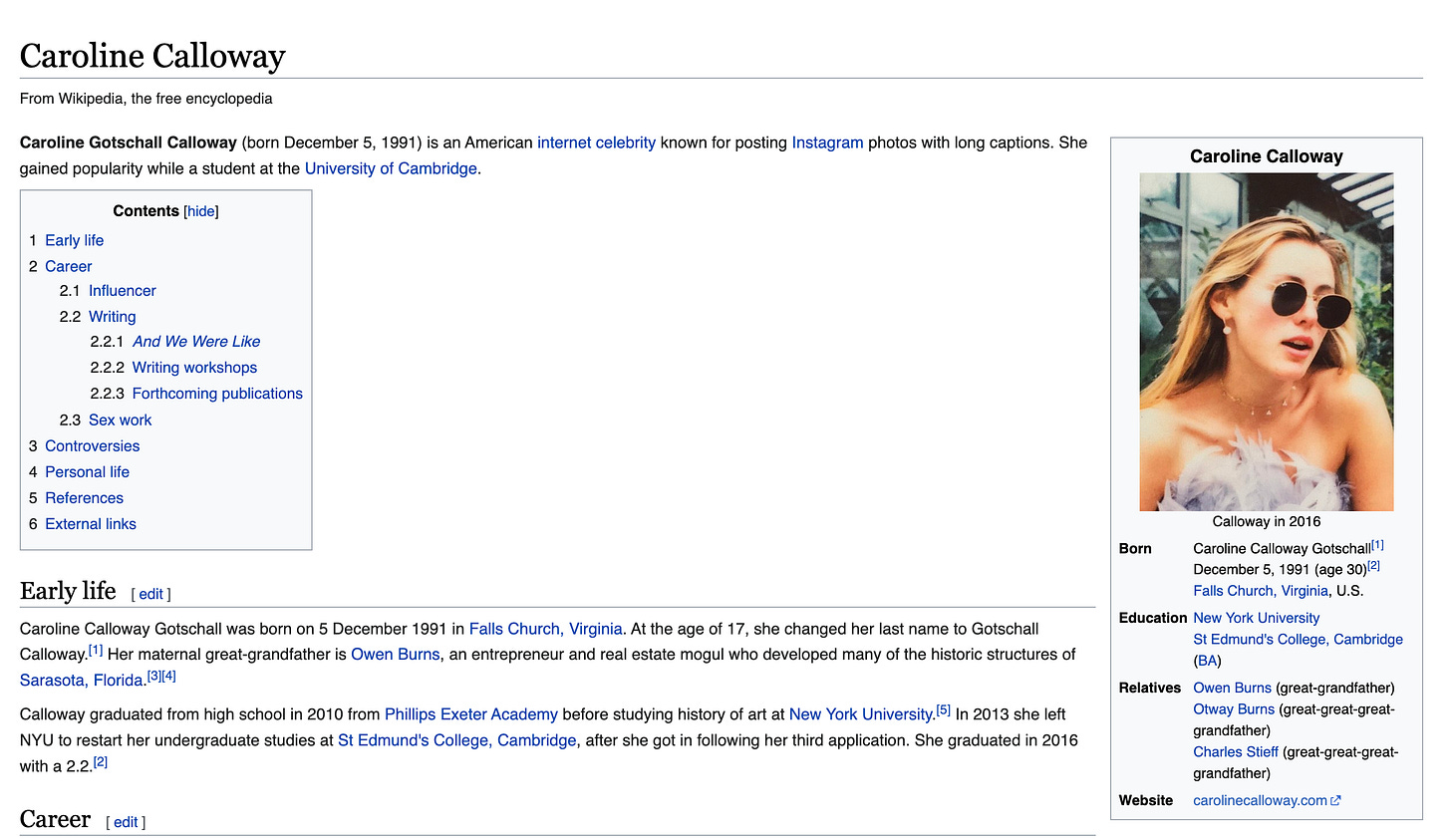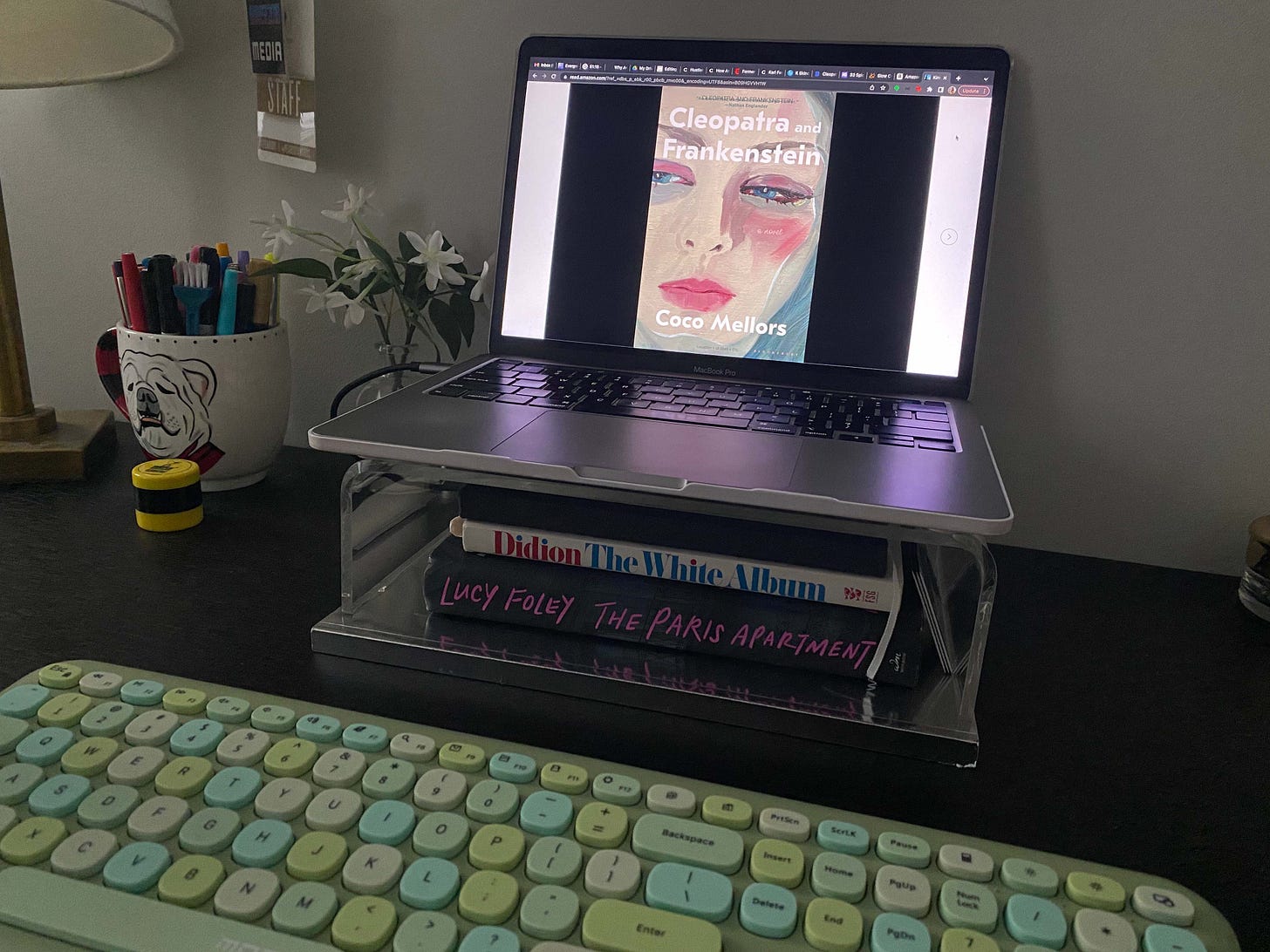Book: Cleopatra and Frankenstein by Coco Mellors
Story: “The Story of Caroline Calloway and Her Ghostwriter” by Natalie Beach for The Cut
*Content/trigger warning: Light spoilers for the book, as well as mentions of drug use and mentions of a suicide attempt.
I can still remember the rabid excitement that washed through my group chat when we heard the first whispers about The Cut essay on Instagram influencer, scammer, and all-around (mostly innocuous) Regina George of the Internet, Caroline Calloway. Some of us had known Caroline since her adventure-gram, Cambridge days and had observed her slow descent into on-line madness. Some of us knew her by the alleged book she’d been promising for years. Some of us just knew her as the “one woman Fyre Festival.” Either way, we—like many others—were positively feral for this tell-all from Caroline’s ghostwriter, Natalie Beach.
I remember the “oh shit” text message sent along with a link. I remember sitting on my bed after class, my room darkening into dusk, but I was to enmeshed with the story lit up on my phone screen to bother turning on a lamp. Those that thirst for Caroline Calloway content, good or bad or chaotic, are niche. But we are dedicated, keen, and vaguely rabid. To put it simply, we enjoy the messy spectacle of it all as much as any gossiper would.
So yeah, when I saw a TikTok that recommended Cleopatra and Frankenstein for the stans (and hate-stans) of Caroline Calloway, I very promptly added it to my TBR list on Goodreads. Sue me.
Written by Coco Mellors, Cleopatra and Frankenstein explores the marriage-of-convenience between 24-year-old Cleo and 44-year-old Frank, and the ways it impacts their combined network of friends. Frank is a relatively successful owner of a marketing firm, while Cleo is an artist from England whose student visa is about to expire.
Cleo is viewed as the sort of quintessential desirable and eccentric jewel of a person to almost every character in the book—a kind of cool girl meets manic pixie dream girl. She’s pretty aware of how she’s perceived and even tries to play into it at times (whether it’s for her sake or those of others isn’t always clear). It’s the same sort of aura Caroline Calloway seemed to exude when her and Natalie first meet.
The way Natalie describes Caroline in the very first sentence of her essay is “a girl who was everything I wasn’t.” She goes on later to elaborate, saying Caroline “seemed like an adult, someone who had just gone ahead and constructed a life of independence.” Confidently aloof in a sexy and an “adult” way that everyone else simultaneously envies and gravitates towards, much like Cleo.
In fact, one character, Eleanor (who works for Frank), observes this exact thing when she meets Cleo. Like Natalie, Eleanor at first feels insecure next to Cleo. Where Cleo and Caroline shine, Eleanor and Natalie see themselves as dull and drab. (It certainly doesn’t help that Eleanor and Frank have been flirting for months leading up to the meeting.) But when Eleanor considers Cleo more and dusts off some of her glamor, she sees the reality. “Cleo, her life, her friends, were still that of a girl’s,” Eleanor says. “I looked older than her when I was eighteen. I probably was older than her when I was eighteen.”
Many a profile on Caroline Calloway has waxed poetic and wondered about her unencumbered-by-life, detached, and unicorn-like nature. Like with any con woman or scammer, we enjoy gawking at her absurdity and how completely unrelatable she feels to us. She doesn’t behave like rest of us, she doesn’t think like the rest of us, she doesn’t rationalize like the rest of us, she doesn’t seem to perceive the world like the rest of us. She doesn’t play by our rules, and yet she succeeds.
“The thing I discovered about Caroline after I met her is that you just can’t easily say no to her; she sucks you in,” Brock Colyar says in their newsletter for New York Magazine, “are u coming?” “Through the screen, you can dismiss her as a crazy disaster, and maybe in so doing reassure yourself that you comparatively have it together. In person, she traps you with her big doe-eyes and a flurry of compliments and scams you of any ability to deny her what she wants from you.”
It creates this mosaic of a person who is equally baffling, infuriating, and also undeniably beguiling in a way you crave. That’s part of what draws us to figures like these, both to observe and to befriend. But what many ultimately realize with characters like these is that we don’t actually want their friendship, loyalty, or even love, in Cleo and Frank’s case. We just want their presence, and to benefit from it in some way.
When Cleo thinks about her relationships with the people in her life—her friend Quentin, her husband Frank, her lover Anders—she sums it up by asking herself: “They want me, they compete for me, but do they care about me?”
And while Natalie certainly cares for Caroline as a friend, what motivates Natalie to befriend Caroline (and what compels her to continue being friends with Caroline, despite how it makes her feel like an afterthought) is what she stands to gain from Caroline. She can’t rely on her the way you should a friend, but she can get something out orbiting around her.
“To my other friends, I described her as someone you couldn’t count on to remember a birthday but the one I’d call if I needed a black-market kidney,” Natalie says about her friendship with Caroline. “What I meant was that she was someone to write about, and that was what I wanted most of all.”
It’s why Natalie ghostwrites Caroline’s Instagram captions and later her book—because she liked “being bound closer to her, forced to stay in her life through our arrangement” so that Caroline would never abandon her or leave her behind.
All the characters in Cleopatra and Frankenstein engage in varying levels of unhealthy co-dependent relationships. The one that gets the most focus is Cleo and Frank. Their relationship starts in the cozy realm of friendship before getting warped by the desires, vices, and indiscretions of the two people in it. The marriage ends up shackling them together in the most parasitic of ways, and their efforts to make each other happy are severely dampened by that fact.
The tension comes to a head after Cleo attempts suicide and Frank finds her in their apartment. After a stay in the hospital, Frank decides to take her to a cabin upstate and the location where he proposed to Cleo nearly a year before. When they return, the cabin—much like their relationship—has lost any sparkle. Everything inevitably cracks and the two end up fighting, a la Scarlett Johansson and Adam Driver in Marriage Story (sans the punching a wall). The fight is the kiss of death in their uncoupling, and they realize they can no longer be together. The two separate before eventually divorcing and then going on to lead individually happy lives, while still remaining friendly acquaintances.
The epiphany Cleo and Frank reach at the cabin mirrors Natalie’s when she flies out to Cambridge to stay with Caroline and finish the book manuscript in time for Caroline’s deadline. The scene Natalie arrives to is a dorm room with torn-up wall-to-wall carpet that left wood splinters in your feet (because Caroline wanted exposed wood floors), “a trash can full of daffodils beside a trash can full of prosecco corks,” and Caroline wearing the same dress multiple days in a row.

What ultimately does Natalie and Caroline’s friendship in is their infamous trip to Amsterdam. Bolstered by Caroline and tired of “being the foil to a hot girl,” Natalie tries hooking up with the bartender at a pub. Caroline had left Natalie to her devices earlier, taking the key to their shared Airbnb and encouraging her with a whispered “he’s so cute!” When Natalie returns to the bartender, he asks where Caroline had gone and then offers the bar’s bathroom stall as the setting for their coupling.
Natalie asks him to take her back to the Airbnb, except Caroline won’t answer the door or reply to any of Natalie’s messages to let her in. Natalie ends up wandering the streets of Amsterdam and getting harassed by men throughout the whole night. All the while, Natalie fruitlessly tries to reach Caroline and slowly begins to think something had happened to her. At noon, Caroline finally wakes up and lets Natalie in.
“This is what I tried to tell you,” Natalie recalls screaming to Caroline. “Men treat me differently than they treat you. Everyone does. And the really messed up thing is that whole night I thought something terrible had happened to you. But you forgot I existed.”
Between the failed trip and the disastrous time in Cambridge, the cracks in the Venus de Milo of Caroline Calloway and what it means to be her friend begin to reveal themselves. When Natalie returns to Brooklyn later, she suddenly sees the reality of the person she’s become obsessed with pleasing.
“I had held on to the fantasy that [Caroline] didn’t care about that small stuff because she was busy with the grand plans that would change my life. I had built my whole career around my commitment to her persona—crafting it, caring for it, and trying my hardest to copy it, spinning out onto the streets of a strange European city as if the world existed to take care of me,” Natalie explains. “Now I saw Caroline for what she was—a person in need of help that I didn’t know how to give.”
We’ve all had a Caroline and Cleo-esque people in our lives. Who could wear bright red platform boots with stars on them with any outfit, and it actually look stylish. Someone who possessed an effortless shine we hoped would rub off on us if we just spent enough time around them. We wanted to be in their good graces, even if it meant sacrificing some of ourselves in the meantime. We perverted what it meant to be a loyal and compassionate friend in order to justify what we would do for them.
You don’t realize it at the time. You just think the other person can help you achieve your interests and provide some company along the way. But then, when you really think back about it, you realize you were never really friends but more so mutual parasites—feeding off each other in the hopes one of you might gain something.
“It seems obvious now, the way the story would end,” Natalie says. “But when I first met Caroline Calloway, all I saw was the beginning of something extraordinary.”
If you, like me, are still fixated on the Yale plates and want more books like these…
I personally have Cover Story by Susan Rigetti on my list. It was recommended to me by a friend, and the book description is giving major Caroline-Calloway-meets-Anna-Delvey vibes.






